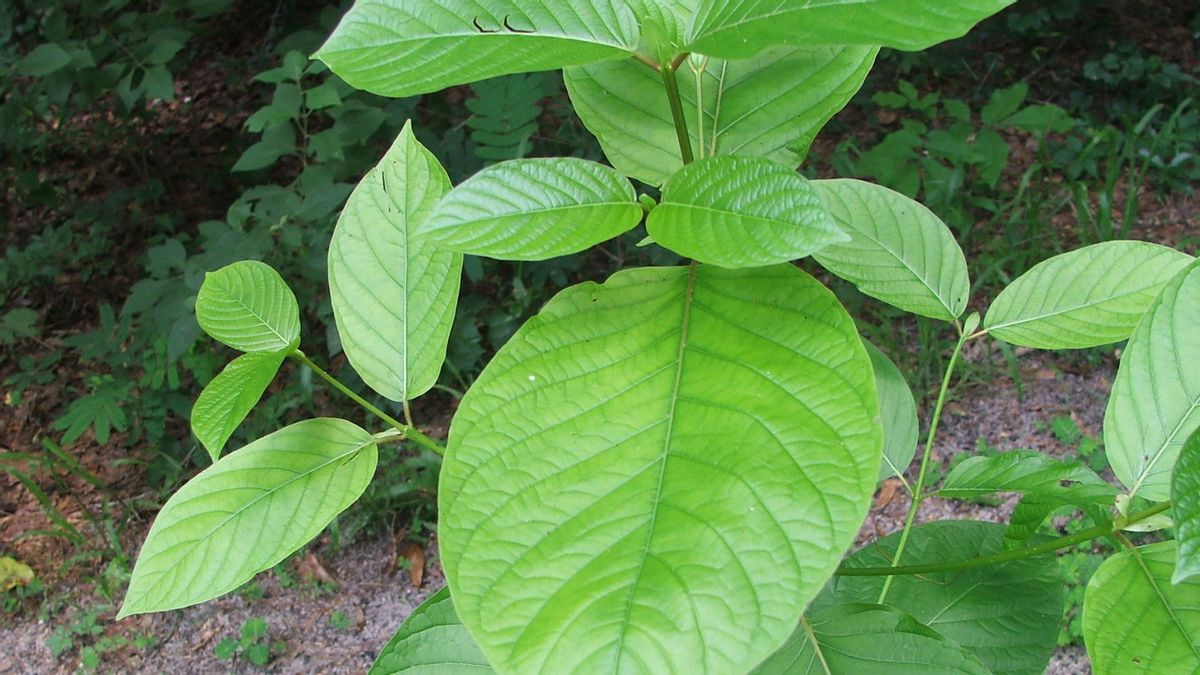JAKARTA - The export of kratom leaves to the Netherlands has become a polemic. The reason is, the leaf with the Latin name Mitragyna Speciosa is included in the class I narcotics, which is said to be more dangerous than cocaine. So if it's banned, why can it be exported?
On Wednesday 29 September 2021, a type of plant in Indonesia, kratom leaves, was exported to the Netherlands. These plants grow a lot in the Kalimantan region and were first exported to the Netherlands via Pontianak Supadio Airport.
Kratom leaves are believed to have various properties, namely herbal remedies for pain relief, anxiety disorders, and sleep disorders. There are various ways to use it, many turning it into a tea concoction form, or into capsules, tablets, powders, and liquids.
The habitat of kratom leaf is Southeast Asia and it is cultivated mainly in Indonesia, Malaysia, and Thailand for medical and recreational use. Kratom is also known as breed, ketum, or Maeng Da. The use of Kratom in Southeast Asia has been documented for at least 150 years.
It is described that kratom leaves have a stimulant effect for heavy workers. Chewed fresh kratom leaves provide energy and an analgesic and relaxing effect when brewed into a tea.
According to the journal "Current Perspectives on The Impact of Kratom Use" written by Charles Veltri and Oliver Grundmann, kratom leaves also served as an opium replacement and mitigation strategy that was widely used in Malaysia and Thailand from the 1830s to the 1920s. The study also states that kratom leaves are used for their antispasmodic, muscle relaxant, and antidiarrheal effects and are a popular home remedy in Southeast Asia.

The use of kratom is prohibited in Malaysia under the Poison Act 1952, but its use remains widespread because the tree grows naturally and the tea herb is available in the local community. Meanwhile, Thailand lifted a ban on the use, production and possession of kratom in 2018 for medicinal purposes.
Community economic supportAs previously explained, one of the original habitats for kratom leaves is in Indonesia, precisely in Kalimantan. No wonder many people cultivate kratom leaves. Many kratom leaves grow in several areas in West Kalimantan, raising the welfare of hundreds of thousands of farmers.
Many people plant kratom trees in front of their houses or gardens. They then sell the leaves in the form of wet, dry, crumbled, or in the form of flour.
Member of the Indonesian House of Representatives from the constituency of West Kalimantan, Syarief Abdullah Alkadrie revealed that the kratom plant is able to raise the welfare of hundreds of thousands of farmers in West Kalimantan. Moreover, the kratom tree can also withstand coastal and river abrasion.
"For state revenue, if properly regulated, it will also provide quite large taxes and customs duties," Abdullah said, quoting Tempo. But there are other problems with kratom leaves.
It is known that kratom leaves are included in class I narcotics. Kratom leaves have an addictive substance four times stronger than cocaine or marijuana. Since 2019, the National Narcotics Agency (BNN) has stated that in 2023 the cultivation of kratom leaves should be stopped and in 2024 the use or sale of kratom leaves should be totally prohibited.

However, the Governor of West Kalimantan, Sutarmidji, questioned the status of the kratom plant, which was declared to have an addictive substance four times stronger than marijuana. Sutarmidji said that there are 200 thousand families living from kratom which is widely exported abroad.
"I said that people who consume kraton are not hallucinating, while marijuana must be hallucinating. Even the urine of people who consume kraton is not necessarily positive," he said.
Sutarmidji also questioned if kratom leaves were really banned, what would happen to the existing kratom trees. There are millions of kratom plants, including in the Betung Karibun area and Danau Sentarum which are designated the lungs of the world by UNESCO. Sutarmidji said that he would send a letter to President Joko Widodo regarding the importance of kratom leaves for the economy of West Kalimantan.
Must be re-examinedIf you look at the problem, kratom leaves are no longer just about the economy. However, there are many kratom trees to withstand abrasion of beaches, rivers, and even the world's lungs. If it is really banned, there will be other problems besides economic problems, namely the destruction of nature.
In terms of law, the status of kratom leaves is indeed different. Currently, kratom leaves are not included in the Regulation of the Minister of Health of the Republic of Indonesia Number 57 of 2017 concerning Changes in the Classification of Psychotropics. Kratom leaves are also not mentioned in the Regulation of the Minister of Health of the Republic of Indonesia Number 4 of 2021 concerning Changes in the Classification of Narcotics.
In fact, kratom is also a potential crop in agriculture according to the Ministry of Agriculture. This is confirmed by the Minister of Agriculture Regulation Number 104 of 2020 concerning Commodities Assisted by the Ministry of Agriculture which includes kratom in it.
However, from the BPOM side, the use of kratom leaves has indeed been banned. This is stated in the Decree of the Head of BPOM Number HK 00.05.23.3644 of 2004 concerning the Principles of Supervision of Food Supplements.
Then the Circular Letter for Supervision of Traditional Medicines and Food Supplements Number HK. 04.4.42.421.09.16.1740 of 2016 concerning the Prohibition of the Use of Mitragyna in Traditional Medicines and Health Supplements.
Seeing the overlapping of these rules, the Public Policy Observer from Trisakti University Trubus Rahadiansyah said that the ban from BNN should be reviewed. He said, it would be better if a separate rule was made for the legality of kratom leaves. Moreover, kratom itself is believed to be part of agricultural products.
"So in my opinion, the leaves are included in the types of agricultural products. The National Narcotics Agency considers them to contain drugs and are addictive. (It is better) to make separate rules," Trubus told VOI.
In addition, it is very likely that kratom leaves are used as part of spices. Considering some traditions make kratom leaves as medicine and herbs, as well as ginger or turmeric which are also often used as herbal medicine ingredients.
"It could be that the kratom leaves are included in the spice group. Even the president also said to restore the glory of spices. It won't be addictive," added Trubus.
Trubus said that BNN should not rush in setting a ban. Needs to be studied more deeply. And according to him there is still an opportunity to do research on the kratom leaves.
Other policies that need to be considered are policies that defend the side of farmers. Moreover, farmers live depending on the harvest of kratom leaves not only for a week or two, but for years. More extensive research and confirming the status of cretom leaf as an agricultural product also needs to be done seriously.
"The BNN ban should have been reviewed first because the inclusion of kratom leaves as a narcotics group must also be questioned. Moreover, the PP and Permenkes do not yet exist," concluded Trubus.
*Read other information about drugs or read other interesting articles from Ramdan Febrian Arifin.
Other BERNASThe English, Chinese, Japanese, Arabic, and French versions are automatically generated by the AI. So there may still be inaccuracies in translating, please always see Indonesian as our main language. (system supported by DigitalSiber.id)









